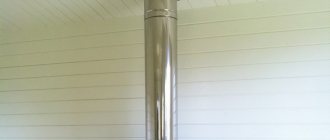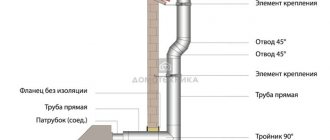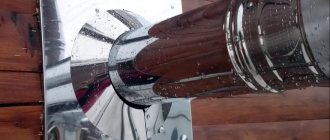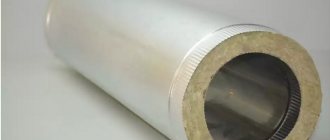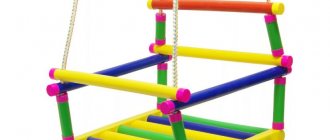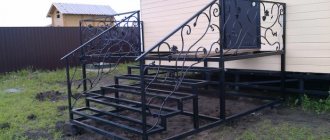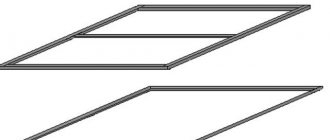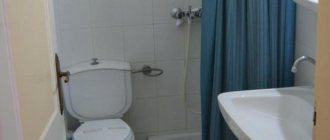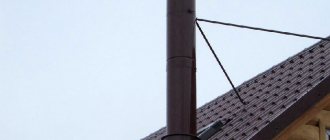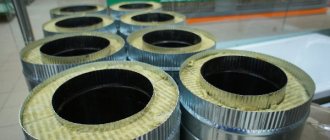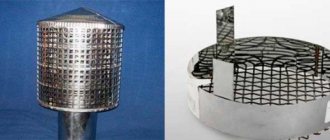We cannot imagine a home without heating. Our concept of comfort unconditionally includes a suitable temperature regime. There is no central heating in a private house, and each owner solves the heating problem in his own way.
We welcome our regular reader and bring to his attention an article about chimneys for stoves - an absolutely necessary component of any heating system, be it a stove, a modern fireplace or a boiler with automatic fuel supply.
How the chimney works
The main part of any chimney is a vertical pipe structure. Structurally, the familiar brick stationary box differs from modern prefabricated counterparts made from ready-made factory-made modules.
A traditional brick pipe includes the following elements: a neck for connecting to the furnace, a riser with valves, a slope, an otter, a neck (at the point of passage through the roof), a headband, and sometimes a metal cap.
Homemade chimneys made of metal or asbestos cement include pipes, caps, adapters for connecting to the stove, and insulation.
The most modern types of chimneys are ceramic and three-layer sandwich pipes. The ceramic structure consists of an external expanded clay concrete frame, an internal prefabricated ceramic pipe, and a layer of insulation between them. The ceramic and sandwich structure itself includes the following blocks: straight blocks for collecting condensate, tees, modules for cleaning, transition elements for connecting heating units. An integral part of a modern chimney is the deflector.
Video description
About brick, ceramic and steel chimneys in the following video:
- Pipes are quite fragile , so they need a casing for protection. Often the consumer is offered a product without a box and insulation, which leads to additional costs.
- The quality of ceramics varies , making some ceramic chimneys vulnerable to damp environments and acidic condensation.
Most of the shortcomings are neutralized in the UNI ceramic chimney.
Schiedel specialists have developed a system designed for all types of heating devices. The chimney has the following advantages:
- Safety . UNI is a system with a minimum level of heating of the external surface. All elements of the system meet fire safety requirements, which is confirmed by the VNIIPO EMERCOM of Russia.
Features of the UNI chimney Source heatsystems.ru
- Quality . The UNI system is manufactured in accordance with all European and Russian requirements and internal standards. All ceramics for the Schiedel UNI system are produced in Germany, at the Schiedel plant.
- Equipment . The system is equipped with a decorative URATOP shell made of fiber concrete or a stone shell (made of expanded clay concrete blocks) with a front panel made of mineral fiber.
- Life time . All main components: ceramic pipe, insulation, stone shell have a guaranteed service life of 50 years.
The UNI ceramic chimney has been successfully sold in European countries since 1985, as evidenced by the title of sales leader; It has been sold on the Russian market since 2009. The system is used in low-rise and cottage construction, and it can be used both during the construction of new buildings and during reconstruction.
Method of fixing the ceramic system Source samstroy.com
Types and designs
The design features of the chimney primarily depend on the material from which they are made.
According to the material, chimneys are:
- brick;
- reinforced concrete (usually industrial);
- asbestos-cement;
- of steel;
- ceramic;
- three-layer metal - two layers of steel with mineral wool insulation between them.
By design, chimneys are:
- indigenous - the structure has its own foundation;
- wall, built into the load-bearing walls of the building;
- mounted - light pipes are mounted on a vertically located outlet pipe of a boiler or fireplace (and potbelly stove);
- Often lightweight structures are simply suspended from the supporting structures of the building;
- coaxial - arranged on the “pipe-in-pipe” principle. The most common example is horizontal gas vents of gas heating boilers. It is used in devices with a closed combustion chamber and ensures maximum safety for residents. Save fuel consumption. Recently, vertical structures of the Shidel system have appeared, taking combustion air from the roof of the house (just below the top).
The service life of such a chimney
The service life of chimneys depends on the designs and materials from which they are made.
A ceramic chimney will last up to 40 years. Manufacturers declare 50 years or more, but no one has checked it yet. A brick one can last longer, but stainless steel liners will have to be replaced after 15-20 years. The service life of the liner primarily depends on the thickness and grade of steel. The thickness of the liner steel should not be less than 0.8-1.0 mm. Galvanization will not last long.
A good quality sandwich will last for 15-20 years or even more. The service life depends on the material and thickness of the inner liner - a good stainless steel inner liner with a thickness of 1 mm will last 20 years. Enameled liner made of carbon (“black”) steel – 15 years.
The service life of the liner depends on the type of heating unit (more precisely, on the type of fuel and the heating temperature of the exhaust gases). The shortest service life is for chimneys for fireplaces and coal boilers, which release very hot gases during intense combustion. The service life of chimneys from boilers and fireplaces using peat, briquettes and wood is slightly longer. Chimneys for pellet and gas boilers will last the longest.
Which one is better to choose?
The choice of chimney largely depends on the parameters of the installed heating unit (design, temperature, type of fuel used), the degree of readiness of the house (we are modernizing an old house with a stove and a wall pipe, the house is only “in design”, or the load-bearing structures have already been installed, or there is already finishing) ; heated volumes.
Features of various types of chimneys are given in the table:
Table 1
| Name | Advantages | Flaws |
| Brick | Durable and high temperature resistant masonry construction, durability depending on the liner material. | Complex installation requiring highly qualified masons; heavy weight, need for a foundation; long installation time, the need to replace the liner approximately every 10 years. When working with modern boilers and fireplaces, a brick without a liner can collapse in literally 10 years. Wall structures can only be installed during the construction of a house. |
| Ceramic | Service life up to 50 years, smooth internal surface, high installation speed; high acid resistance, good thermal insulation; withstands temperatures up to 550° | Expensive option; installation requires some qualifications; there is a need for a foundation; fragility |
| Single-layer steel (and asbestos-cement) | Smooth inner surface, lightweight, inexpensive, high speed of installation, easy to repair; resistance to corrosion and condensation | Insulation required; When passing through structures made of flammable materials, large offsets are required; They burn out in 10-15 years, there are no components - during installation you will have to make all the elements yourself. Galvanization will last five years (or less) |
| Steel sandwich type | Long service life, smooth inner surface, light weight, quick easy installation, easy repairs, high resistance to corrosion and condensation; can be installed/suspended outside the building; good thermal insulation | Quite expensive elements |
You should not use flexible steel corrugation - they burn out very quickly.
Despite the price, it is worth choosing modern ceramic chimneys or “sandwich”. If necessary, they can be installed both in a finished house and outside the house, they are durable, fairly easy to assemble, resistant to high temperatures, well insulated, and have a large assortment of ready-made factory elements.
If you want to use an old wall box from a conventional heating stove, you need to insert a stainless steel liner and insulate it. But perhaps you should choose a sandwich - there will be less hassle.
Step by step assembly guide
In order to assemble the chimney efficiently and correctly, it is necessary to act strictly according to plan. This will help get the job done very quickly and efficiently. It is worth remembering that if it is possible to change the plan and do the job better, then you can make amendments:
- Since all brackets are directly attached to the wall, no foundation is required.
- The boiler and pipe must be connected with an adapter.
- The first pipe already has a gate. Next, you need to connect a container to collect condensate.
- You need to make a hole of 50 centimeters in the wall. The entire system of stops is mounted in it and the pipe is installed. Next, everything is covered with non-combustible materials and insulation.
- The sandwich is passed through a pipe. The hole will need to be filled with asbestos sheets.
- Pipes must be assembled according to the bottom-up principle. All work is done from the heating element to the deflector.
- Do not forget about sealant and fastening with brackets. The distance between them should not exceed 1.2 m.
- At the very end of the pipe it is necessary to attach a deflector.
- To provide maximum rigidity, an additional system of braces and fastenings is used.
- Testing a boiler or stove. It is necessary to test the new chimney and correct any errors, if any.
Do not use pipes of different diameters: this may cause a fire. The transition from a brick structure to a steel one is unacceptable. The only way out in this situation is to use cartridges.
Make it yourself or order it
You can make some elements yourself for installing single-layer pipes or lay out a brick structure (if you have the skills of a qualified mason).
But the installation of prefabricated structures can be done with your own hands - this will help save a considerable amount from the family budget. You will have to pay a lot for the services of a qualified team - the amount is comparable to the cost of materials. There is a risk of running into unskilled workers.
When deciding whether to do the work yourself, you need to carefully analyze your capabilities:
- How accessible is the roof;
- do you have friends or relatives who can help;
- Do you have a fear of heights?
- What are your qualifications in performing repair work?
Disadvantages of brick chimney pipes
Like most materials, a brick chimney for a fireplace also has some disadvantages. One of them is a short service life (7 – 10 years). In addition, temperature changes in winter will inevitably lead to the formation of condensation on such pipes, which, after numerous freezing and thawing, will cause destruction of the brick chimney masonry.
However, the impact of this negative factor can be significantly reduced by using one of the following actions:
- increase the cross-section of the chimney for the fireplace, or rather, its external walls to 25 centimeters in those areas that are above the roof;
- insulate this sector of the pipe with mineral wool.
Another disadvantage of a brick chimney is a large number of irregularities on its inside. In this case, the draft efficiency is significantly reduced, which cannot be said about chimneys with a smooth inner surface. To avoid such a problem, even at the design stage, the chimney should be provided with a certain cross-sectional reserve.
When installing fireplaces and chimneys, the use of galvanized steel chimney pipes mounted inside will also increase the service life.
Building regulations
The installation of chimneys is determined by the provisions of SNiP 41-01-2003.
The chimney design must meet the following regulatory requirements:
- the minimum height must be at least 5,000 mm or grate;
- when located on the roof slope at a distance of less than 1.5 m to the ridge, the pipe should be 500 mm higher than the ridge;
- when located on the roof slope at a distance of 1.5-3 m to the ridge, the pipe must be no lower than the ridge;
- when located on the roof slope at a distance of more than 3 m to the ridge, the angle between the horizontal and the line passing through the ridge and the top of the pipe should be no more than 10°;
- the head must rise above the flat roof to a height of at least 1,000 mm;
- the maximum length of each horizontal and inclined section should not exceed 1000 mm, the total length of their projections onto the horizontal should not exceed 2000 mm. If there are oblique and horizontal sections, it is necessary to extend the pipe by the length of the horizontal projections. For ceramics, horizontal sections are not allowed.
Production of chimney and ventilation pipes
Series D1
Article: 155
D1 series chimneys are designed to remove combustion products from boilers operating…
Height, m 7-15
- Diameter, mm 150-600
- Number of trunks, pcs 1-3
- Flue material Stainless steel steel
Series D2
Article: 156
Smoke pipes of the D2 series are designed to remove combustion products from boilers operating…
- Height, m 7-60
Series D3
Article: 157
D3 series chimneys are designed to remove combustion products from boilers operating…
- Height, m 15-35
Series D4
Article: 158
D4 series chimneys are designed to remove combustion products from boilers operating…
- Height, m 15-40
Series D5
Article: 159
Smoke pipes of the D5 series are designed to remove combustion products from boilers operating…
- Height, m 20-60
Series D6
Article: 160
Smoke pipes of the D6 series are designed to remove combustion products from boilers operating…
- Height, m 40-150
The market offers a wide selection of heat sources (boiler houses, generators, etc.). As a result, the solution to organizing high-quality smoke and gas removal requires more complex design structures among standard and individually developed models.
Structural features of steel chimneys
Every steel chimney project requires consideration of a huge number of characteristics and aerodynamic parameters. You can buy a standard project based on its characteristics and suit your requirements, or order an individual one. The company’s specialists will carry out the necessary calculations in accordance with all requirements and standards.
Steel chimneys for boiler houses consist of three main parts. Let us indicate them according to construction:
- Foundation. More often it is an element resting on a reinforced concrete pipe, cylinder or truncated cone in the form of a glass in the upper part. The latter makes it possible to remove ash or introduce supply channels. The foundation is built based on the structural features of the chimney.
- Pipe trunk. Can be cylindrical, conical or a combination of shapes. It consists of a base at the bottom, a base floor and the input of supply channels. At the top there is a pipe head and thermal insulation materials along the entire surface of the structure.
- Pipe set. It has a walking staircase, traffic light platforms for light barriers, protection from thunderstorms and guy wires (if required by the design).
A walking ladder is used to climb to platforms. When reaching 10-15 m, a fence is attached to ensure the safety of progress. The platforms are installed from lattice panels (material - steel) or expanded metal sheets.
Lightning protection has several lightning rods and grounding. The first ones are made of steel pipe whose diameter is 38 mm. They rise 1.8 m above the head. Grounding is made of steel electrode pipes, which are driven into the ground. The length is 2.5 m.
Fire safety requirements for chimneys
The distance from the surface of ceramic, insulated steel and asbestos-cement chimneys to combustible house structures must be at least 250 mm; for brick chimneys and sandwich pipe structures - at least 130 mm.
It is necessary to protect building structures made of combustible materials using cement or gypsum plaster on a mesh with a thickness of at least 25 mm.
If the roof covering can burn (roofing felt, bituminous tiles, ondulin), or leaves or fluff can accumulate on it, a mesh spark arrester must be installed on the roof cap.
Remember that the life and health of your loved ones depends on the quality of smoke removal.
Chimney pipe
A self-made chimney pipe is more practical and can be used for various designs. You should carefully consider your choice, as you may end up with a device that does not have the required characteristics. Main materials used:
- Black steel is considered the simplest and cheapest. It is very lightly covered with soot. Such a pipe does not require a foundation for installation, and installation does not require much effort. The disadvantage is high thermal conductivity, due to which the steam quickly cools and turns into condensate, which settles on the pipe. Due to the high thermal conductivity, the place where the pipe touches other elements and structures will have to be additionally protected. For this reason, black steel cannot be used for external chimneys.
- Low alloy steel is produced by adding nickel, chromium and molybdenum to ferrous metal. It has the same set of characteristics as black steel, but it corrodes much more slowly.
- Galvanized iron is the worst option for a chimney pipe. Such material burns out very quickly and begins to rust prematurely.
- Stainless steel is the leader among all materials. It is easy to process, which allows you to perform work of any complexity. Due to the smoothness of the steel, soot settles very poorly on the pipe. The stove will light up very easily, and a steady draft will only help with this.
Traction force
Factors influencing traction force:
- pipe height;
- condition of the surface of the internal channel - regularity of soot removal, wall roughness;
- the presence of inclined or horizontal sections. The presence of horizontal and inclined sections is undesirable, since lengthening the chimney is undesirable - the gases will cool, the draft will decrease until it tips over;
- installation of a deflector;
- quality of insulation;
- air supply to the firebox.
Your safety depends on the force of traction, so it is necessary to regularly check the presence of traction and take measures to clean the channel from soot and the pipe head from ice.
How to remove soot
It will be safe and comfortable to have a fireplace in the house only if there is good draft in the chimney. And this largely depends on his condition.
There are several cleaning methods for chimneys: there are traditional ones, which people have used for centuries, and modern ones, based on scientific developments. These methods include:
People's
In the old days, chimneys were cleaned with aspen wood, which could generate heat in the firebox up to 1200C. Under such influence, the soot becomes loose and burns, and everything that remains of it flies out along with the smoke into the chimney.
Before cleaning using this method, you must be sure that such high temperatures will not harm your chimney, since it will be difficult to avoid destruction or fire if the chimney, for example, cracks.
Even in the old days, they used another method of cleaning the chimney: they burned dried potato peelings, the combustion of which released substances that could loosen the soot, and then it was easily removed from the cleaning holes. But traditional methods will not always help, and in case of severe blockage it is better to turn to chemistry.
Chemical
Today, you can find a variety of cleaning products for cleaning chimneys in the stove store. It can be powder, tablets, liquid or special pellets, logs and briquettes, which are simply placed in the firebox (with or without firewood) and burned. More details about the use of each chemical are described in the instructions supplied with them.
Cleaning briquettes are considered the most convenient of all chimney cleaning chemicals. They heat the fireplace for about two hours, due to which the substances that bind the soot in the chimney are destroyed, and the remaining fines are carried out, like the smoke, into the chimney.
If there was a large blockage in the pipe, it will fall down, and therefore, after servicing the chimney, an inspection of the entire chimney space is necessary, for which there are special doors.
Mechanical
This method is the most effective and will cope with the most serious blockage, which occurred due to a severe narrowing of the lumen or due to some debris getting into the pipe.
Chemistry may not be able to change anything here.
And operating such a fireplace is dangerous not only for health, but also for life - all the deposits formed inside the chimney can catch fire, not only smoke, but also sparks and even fire can escape from the chimney.
If the weather is dry, there is a high probability of a fire, so if there is no draft and the room begins to fill with smoke, mechanical cleaning of the chimney using special tools and devices will be required.
Devices designed for mechanical cleaning of a fireplace chimney from soot and soot include special scrapers, brushes, brushes of different sizes and configurations, and weights in the form of cores to break through dense blockages.
All this is on sale, but you can do a lot yourself.
It may not be necessary to clean the chimney often, but if the soot deposit inside the chimney exceeds 2 mm, then it’s time to work as a chimney sweep.
Making and installing a chimney with your own hands
What materials are best to make it from?
The easiest to install are steel structures. Single-layer steel products require insulation and the manufacture of components - in general, work for pathological workaholics, and here we will not consider their installation.
Installing a chimney made from a sandwich pipe is quite simple; the availability of a large number of various elements and components in stores allows you to assemble a device of any configuration.
Drawing and diagrams
Before starting work, decide on the dimensions and draw a diagram or drawing - this will help to correctly calculate the required amount of materials and properly organize the work.
Size calculation
The height of the pipe is determined in accordance with the requirements of SNiP 41-01-2003, but should not be lower than 5 m from the grate. The diameter is assumed to be equal to the diameter of the outlet of the heating device.
What not to do when arranging a chimney for a wood-burning stove
You should not equip several stoves with a common chimney. Each heating device must have its own pipe.
Advice! A common chimney for several heating devices is allowed only if they are located on the same floor. However, it is necessary to provide two cuts and valves.
Do not vent smoke into ventilation ducts.
It is unacceptable to install exhaust ventilation together with a chimney.
Installation features
Installation begins from the stove or fireplace. The first starting element is mounted on the boiler or furnace pipe. This element does not have insulation for technological reasons (the alt-free filler melts and sinteres into stone). All elements are designed in such a way that one end has a smaller diameter and is inserted one into the other, like into a socket. One of the docking options is to slightly pull out the inner pipe and insert it into another inner pipe. Press down. Then lower the outer pipe with insulation along it and press down. Secure the connection with a crimp clamp and tighten it with a bolt and nut. All joints must be coated with sealant.
Then a tee is mounted, modules with a cleaning hatch and a condensate drain are mounted below. There are designs for installing the lower part of the chimney on the floor.
Then the rest of the structure is installed. After a meter, the sandwich is attached to the wall with special brackets. An element with a cleaning hatch must be installed on each floor and in the attic.
It is advisable to connect the chimney elements “via condensate” - the pipes are mounted in such a way that the upper one is inserted into the lower one and the condensate cannot seep through the joints, but flows down the walls into the condensate drain.
An element with a gate is mounted under the ceiling.
The passage of the pipe in the ceiling is covered with a galvanized sheet and filled with insulation. The distance to structures must be at least 130 mm.
The most difficult stage of installation is the roofing. Mark a hole in the desired location on the roof. Make a hole in the roof. The under-roof sheet is attached from the inside, and the roof trim is installed on the roof. It is selected depending on the angle of the roof. The cutting edges are placed under a sheet of roofing material.
If necessary, install stretch marks. Install the deflector.
Types of steel chimneys
Steel chimneys vary in pipe material and type of construction. Steel is used in several varieties:
- Black without coating. This material is the cheapest, but at the same time the least durable. Such steel is susceptible to corrosion and quickly becomes unusable.
- Low alloy steel. Chromium, zinc, nickel, and molybdenum are used as impurities for this material. This alloy is less susceptible to corrosion than ordinary black steel.
- Stainless steel. The best possible option. Pipes made of this material have all the advantages of steel chimneys.
- Corrugated steel. It is the least reliable option, since due to the corrugated wall, soot quickly settles on the pipe. Such a chimney will have to be cleaned frequently. Corrugated material is used for lining.
This is interesting! Restoration work on old stove chimneys is called lining. In this case, a new, usually steel, pipe is placed inside the existing brick frame. Lining can significantly improve the aerodynamics of an old chimney.
Based on the type of structure, the following types of chimneys are distinguished:
- Single-walled. Such pipes have one wall, with a diameter of 0.6 to 1 mm. They do not have thermal insulation, so it is dangerous to use them for heating appliances in the house. They have found application in bathhouses, where water can be heated using a constantly hot pipe.
- Single-walled for sleeving. Such pipes may be no different from ordinary single-wall pipes; they may be corrugated or have an oval shape. Their distinctive feature is their location inside an old brick chimney.
- Sandwich systems. The most common and reliable of all options. They consist of inner and outer pipes, between the machines there is a layer of insulating material. This design avoids heating the outer surface of the pipe and the formation of condensation.
- Pipe-in-pipe design. This system differs from the previous version by the absence of an insulating layer. Such chimneys are called coaxial. The inner pipe in them is needed to remove combustion products; air moves through it from bottom to top. Along the outer pipe, that is, the layer between two pipes, air flows move in the opposite direction. They are necessary to maintain fuel combustion. This design helps to increase draft in the inner pipe, but it cannot be used in low temperature conditions due to freezing of condensate on the walls.
We recommend that you read: Compression fittings for installation of steel pipes
Frequent errors and problems during installation
The most serious mistake is the lack of a condensate collector and elements with hatches for cleaning.
In places where structures pass through ceilings, it is strictly forbidden to install joints of individual elements - leaking hot smoke can cause a fire.
A very significant mistake is the absence of a deflector or at least a cap over the chimney.
Snow and rain should not get inside the pipe - they increase the formation of condensation, and ice can block the cross-section of the pipe.
Stainless steel chimneys for fireplaces
These pipes are assembled elements made of stainless steel, and their thermal insulation is carried out using flammable materials.
Chimneys of this type can have different diameters and lengths. The kit often includes ceramic pipes that are mounted inside steel pipes.
A galvanized steel chimney has a number of advantages:
- due to their light weight, sandwich chimneys for fireplaces can be installed without a foundation (read: “Sandwich pipes for a chimney - installation”);
- such a chimney can be installed even after the entire construction process is completed;
- a stainless steel chimney pipe is cheaper than block and ceramic chimneys;
- Individual parts of the chimney can be easily replaced if desired.
Information with photos on installing chimney pipes made of stainless steel can be found on our website if desired.
Maintenance and cleaning
Any chimney requires regular cleaning of soot. This will avoid fires and reduce draft. Cleaning should be done 2 times a year.
There are two cleaning methods - mechanical and chemical.
With chemicals, special products are burned in the firebox. They burn at a very high temperature and accelerate the wear of the internal walls of the chimney, so it is better to use mechanical cleaning methods for the sandwich.
Icicles and ice from condensate can freeze on the head - they block the cross-section of the duct and reduce draft, which increases the risk of carbon monoxide poisoning for residents.
Correct use and care
If everything is done correctly, you can get a chimney that will last at least 15 years. It is worth adhering to the basic requirements. So, you cannot change the boiler if the temperature of the gases exceeds the maximum permissible temperature for the current chimney. It is advisable to check the quality and condition of the thermal insulation in the wall opening more often so that condensation does not linger.
Cleaning is an integral part of operation. The chimney must be cleaned at least once every three months. It is better not to use the mechanical method. The best option is to use chemicals that are impregnated and sold in special briquettes. When burned, they release a substance that dissolves soot and other deposits.
Expert advice
It is necessary to choose pipes in which the thickness of the outer metal layer is 1 mm (not 0.5 mm). It’s very easy to check - for a product with a thin wall, the wall bends if you squeeze it with your hands.
When installing sandwich structures, it is necessary to use a special sealant for high operating temperatures (automotive sealant with an operating temperature of 500° is not suitable).
If the pipe rises more than one meter above the roof, it should be reinforced with guy wires.
The places where the sandwich passes through the roof and ceiling must be additionally insulated.
Criteria for choosing a chimney: configuration and diameter
The pipe is selected based on the volume of the steam room, that is, after the general layout and dimensions of the steam room become known. The main selection criteria are the pipe configuration and its diameter. The configuration is determined by the following parameters:
- The method of connecting the pipe to a sauna stove (to a fireplace, boiler) . For example, for a metal wood stove, there are usually two options: from behind (side) or from above. You will need an adapter for fixation. Our Permeter chimney system has three installation methods: floor, wall, mounted (on the firebox).
Installation of the pipe from above Source koffkindom.ru
- The method of bringing the pipe to the street . Output through the wall is limited to one hole. This solution will be technologically simpler, but less efficient in operation. A vertical (through the roof) chimney can boast better characteristics, but it is more difficult to install, since its path runs through at least one ceiling and roof. An additional plus is that you can install a “samovar” type water tank on the vertical chimney.
The productivity of the furnace is selected taking into account the volume of the steam room (1 kW of furnace power per 1 cubic meter of steam room). Consequently, the calculation of the diameter depends on the size of the room. According to the rules, for 1 kW of power (for a wood-burning stove) there must be at least 8 cm² of pipe cross-sectional area.
Knowing the minimum required cross-sectional area, you can use the formula for the area of a circle from the school course to calculate the diameter. The resulting value must be rounded up; in any case, the diameter should not be less than the outlet from the furnace to which the pipe is selected. There is an alternative way: the diameter can be selected according to the finished diagram; for this it is enough to know the power.
Methods for removing the pipe Source banipechi.by
Advantages and disadvantages of ceramic chimneys for fireplaces
The advantages of a ceramic pipe include the following characteristics:
- the material is very quick to install and assemble;
- is a guarantee of high efficiency;
- long service life;
- the range of blocks is large, which makes it possible to mount a chimney opening with any configuration;
- the presence of a special hole that makes it possible to clean the chimney;
- the condensate that appears drains away thanks to the hole located at the bottom of the chimney.
Among the disadvantages of block ceramic pipe systems, it is customary to highlight the following:
- relatively high price;
- Due to the fact that most of these chimneys are manufactured abroad, the delivery time is sometimes very long.
